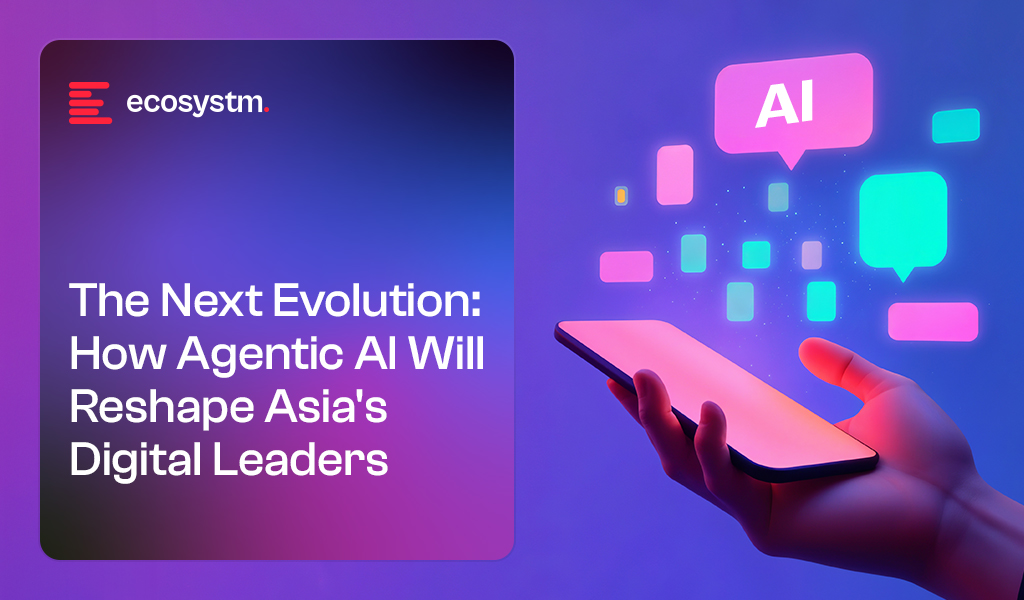Asia is undergoing a digital renaissance. Central to this transformation is the rise of digital natives: companies born in the digital era, built on cloud infrastructure, powered by data, and guided by customer-centric agility. Unlike traditional businesses retrofitting technology onto old models, Asia’s digital natives have grown up with mobile-first architecture, software-as-a-service models, and a mindset of continuous iteration. They’re not merely disrupting — they are reshaping economies, industries, and even governance.
But we are seeing a new wave of change. The rise of Agentic AI – autonomous, multi-agent systems that handle workflows, decision-making, and collaboration with minimal human input – is set to redefine industries yet again. For digital natives, embracing Agentic AI is no longer optional. Those who adopt it will unlock unprecedented automation, speed, and scale. Those who don’t risk being leapfrogged by competitors operating faster, smarter, and more efficiently.
The path forward demands evolution and collaboration. Digital natives must upgrade their capabilities, while large tech vendors must shift from selling solutions to co-creating them with these agile players. Together, they can accelerate time-to-market and build future-ready ecosystems.
Reimagining Scale and Customer Experience
Asia’s digital natives have already proven that scale and localisation are not mutually exclusive. Grab, for instance, evolved from a ride-hailing app into Southeast Asia’s super-app by integrating services that reflect local habits, from hawker food delivery in Singapore to motorcycle taxis in Indonesia.
Rather than building physical infrastructure, they leverage platforms and cloud-native tools to reach millions at low marginal cost. AI has been their growth engine, powering hyper-personalisation and real-time responsiveness. Shopee dynamically tailors product recommendations, pricing, and even language options to create user experiences that feel “just for me.”
But with Agentic AI, the bar is rising again. The next leap isn’t just personalisation; it’s orchestration. Autonomous systems will manage entire customer journeys, dynamically adjusting pricing, inventory, and support across markets in real-time. Digital natives that embrace this will set new standards for customer responsiveness and operational scale.
To navigate this leap, co-creating AI solutions with tech partners will be crucial. Joint innovation will enable digital natives to move faster, build proprietary capabilities, and deliver richer customer experiences at scale.
Reshaping Work, Operations, and Organisational Models
Digital natives have long redefined how work gets done, breaking down silos and blending technology with business agility. But Agentic AI accelerates this transformation. Where AI once automated repetitive tasks, it now autonomously manages workflows across sales, legal, HR, and operations.
Tokopedia, for example, uses AI to triage customer queries, detect fraud, and optimise marketplace operations, freeing employees to focus on strategic work. This shift is reshaping productivity itself: traditional KPIs like team size or hours worked are giving way to outcome-driven metrics like resolution speed and value delivered.
With leaner but more impactful teams, digital natives are well-positioned to thrive. But success hinges on evolving workforce models. Upskilling employees to collaborate with AI is no longer optional. Data and AI literacy must be embedded across roles, transforming even non-technical teams into AI-augmented contributors.
This is where partnerships with big tech providers can unlock value. By co-developing workforce models, training frameworks, and governance structures, digital natives and vendors can accelerate AI adoption while keeping humans at the centre.
Unlocking New Ecosystems Through Data and Collaboration
Asia’s digital natives understand that data is more than an asset: it’s a strategic lever for building defensible moats and unlocking new ecosystems. Razorpay processes billions in payment data to assess SME creditworthiness, while LINE integrates messaging, payments, and content to deliver deeply personalised services.
What’s emerging is a shift from vendor-client dynamics to co-innovation partnerships. Flipkart’s collaboration with tech providers to deploy GenAI across customer support, logistics, and e-commerce personalisation is a prime example. By co-developing proprietary AI solutions – from multi-modal search to real-time inventory forecasting – Flipkart is turning its data ecosystem into a competitive advantage.
Agentic AI will only deepen this trend. As autonomous systems handle tasks once outsourced, firms are repatriating operations, creating resilient, data-governed ecosystems closer to consumers. This shift challenges traditional outsourcing models and aligns with Asia’s growing emphasis on data sovereignty and sovereign AI capabilities.
How Agentic AI Will Challenge Digital Natives
Even for Asia’s most agile players, Agentic AI presents new hurdles:
- Loss of Advantage. Without Agentic AI, digital natives risk falling behind as competitors unlock unprecedented automation and optimisation. What was once their competitive edge – speed and agility – could erode rapidly.
- Adaptation Costs. Transitioning to Agentic AI demands serious investment – in infrastructure, talent, and change management. Scaling autonomous systems is complex and resource-intensive.
- Talent Shift. Agentic AI will redefine traditional roles, enhancing employee contributions but also requiring massive upskilling and workflow redesigns. HR, sales, and operations teams must evolve or risk obsolescence.
Navigating these challenges will require digital natives to evolve not just technologically, but organisationally and culturally – and to seek partnerships that accelerate this transformation.
Digital Natives: From Disruptors to Co-Creators of Asia’s Future
Asia’s digital natives are no longer just disruptors; they are architects of the region’s digital economy. But as Agentic AI, data sovereignty, and ecosystem shifts reshape the landscape, they must evolve.
The future belongs to those who co-create. By partnering with large tech vendors, digital natives can accelerate innovation, scale faster, and solve the region’s biggest challenges, from inclusive finance to smart cities and sustainable mobility.

As rapid technological change, rising citizen expectations, and growing demands for efficiency and transparency converge, the public sector stands at a pivotal crossroads. Profound, system-wide transformation is no longer a future ambition – it is an urgent imperative. From streamlining services and optimising resources to strengthening engagement and building more resilient infrastructure, the challenges and opportunities facing governments are immense.
Now is the time to reimagine how innovation, technology, and a citizen-first mindset can come together to reshape the very fabric of the public sector.
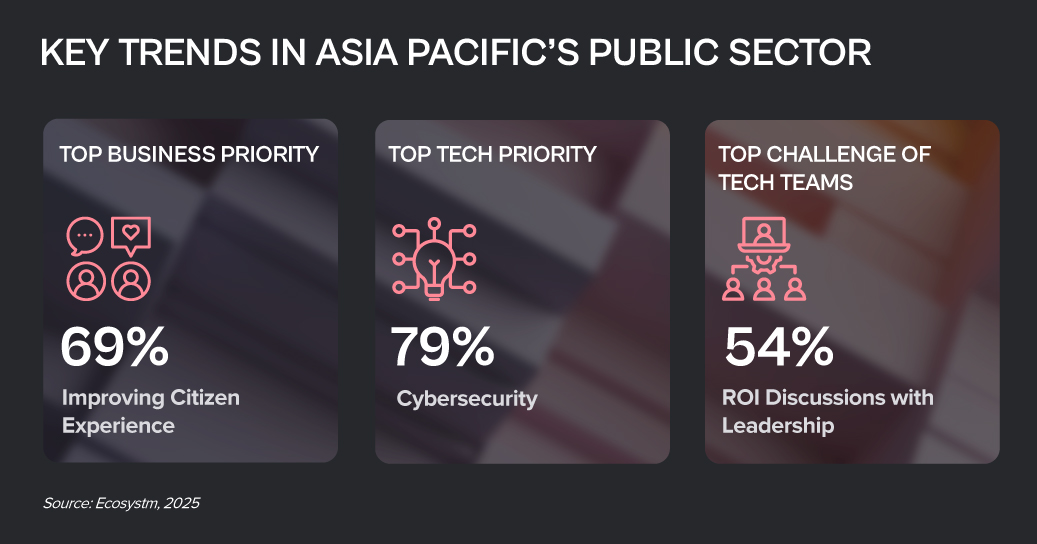
Click here to download “Future Forward: Reimagining the Public Sector” as a PDF.
Smarter City Management with Digital Twin
GovTech Singapore faced challenges in managing data from smart infrastructure as part of its Smart Nation initiative. They needed a more efficient way to visualise and analyse data from sources like smart lamp posts to improve urban management and resource optimisation.
GovTech implemented a digital twin solution that integrates real-time data from environmental sensors and traffic cameras into a dynamic 3D visualisation platform, enhanced by AI-driven analytics for predictive maintenance and resource allocation.
This solution provided valuable operational insights, reduced maintenance costs, and improved responsiveness to urban challenges. It boosted scalability and performance, optimising city planning and advancing the Smart Nation initiative towards more sustainable and efficient urban development.
Digital Leap for Accessible Governance
Scattered across the Indian Ocean, the Maldives faced a major challenge: delivering government services to citizens spread over 1,000 islands without forcing them to travel. The Ministry of Environment, Climate Change and Technology aimed to build a digital economy that could bring essential services directly to every island, while cutting costs and supporting sustainability goals.
The Ministry unified government agencies on a single, secure digital platform, enabling cloud-based collaboration, virtual meetings, and streamlined access to services.
Now, 20,000 public servants collaborate online, reducing travel, paper use, and operational costs. Government services have become faster and more accessible, solar energy projects are managed more efficiently, and citizens can access services – from banking to legal hearings – without leaving their islands. With digitalisation now embedded, the Maldives is laying the groundwork for AI-driven innovation and further advances in sustainable governance.
Enhancing Urban Resilience
With rising flood risks and extreme weather, Melbourne Water needed a faster, smarter way to maintain its 4,000 stormwater grates. Manual inspections were slow, costly, and couldn’t keep up with intensifying storms. Crews struggled to inspect grates across 14,000 sq km, often arriving too late or checking clear grates. Frequent site visits drove up costs, safety risks, and stretched resources, while the city needed to scale inspections without overburdening crews.
Melbourne Water implemented a cloud-based image recognition system with real-time cameras, using AI to detect blockages and trigger work orders only when needed.
The system is expanding beyond trial sites to cover critical points in the drainage network, with early results showing tens of thousands in annual savings and further efficiency gains. By freeing up crews and reducing manual work, Melbourne Water is better prepared to manage flood risks and support the city’s sustainable growth.
Making the Cloud Shift to Address Bottlenecks
The Philippine national police force overhauled its outdated licensing system, where applicants endured weeks-long waits, repeated office visits, and costly delays. Staff were bogged down by manual checks, while on-prem systems struggled with capacity limits, poor scalability, and frequent outages.
By shifting to a cloud-native platform, processing times dropped from four weeks to 24 hours – a 96% improvement.
The system now handles 5x more applications daily, scaling automatically with demand. Secure cloud storage replaced legacy systems, freeing IT teams to focus on citizen services. A nationwide content network and built-in security keep access fast, reliable, and protected. The force is unifying IT on one cloud platform and rolling out disaster recovery to boost resilience and future-proof operations.
Streamlining Employee Services
The New Zealand Parliamentary Service needed a more efficient way to manage employee services. Previously reliant on 11 separate email inboxes and a third-party IT service desk, the system was slow, disjointed, and cumbersome. Onboarding and offboarding were a particularly time-sensitive challenge, often causing delays and frustrations.
To streamline operations, the service transitioned to a unified platform, consolidating services into a single portal.
This move cut response times from weeks to just two days and simplified access to essential services, improving employee satisfaction and operational efficiency. With real-time performance tracking and AI-driven case management, the Parliamentary Service is now equipped to scale and optimise service delivery as it continues its digital transformation.
Enhancing Weather Prediction
The Japan Meteorological Agency (JMA) faces the challenge of enhancing weather predictions, particularly for typhoons and torrential rains, as climate change increases their frequency and intensity.
JMA upgraded its supercomputing infrastructure to boost memory bandwidth and computational power, enabling higher-resolution forecasts and more accurate predictions for linear precipitation zones.
The result: JMA has improved the resolution of its local weather models, extending the forecast time for local predictions from 10 to 18 hours. The new system has also increased prediction accuracy for linear precipitation zones, raising the probability of forecasting these events 15 hours in advance from 33% to higher levels. Additionally, the new infrastructure has reduced the number of nodes needed for some weather prediction models by up to 80%, optimising computational resources for other forecasting needs.

AI is not just reshaping how businesses operate — it’s redefining the CFO’s role at the centre of value creation, risk management, and operational leadership.
As stewards of capital, CFOs must cut through the hype and ensure AI investments deliver measurable business returns. As guardians of risk and compliance, they must shield their organisations from new threats — from algorithmic bias to data privacy breaches with heavy financial and reputational costs. And as leaders of their function, CFOs now have a generational opportunity to modernise finance, champion AI adoption, and build teams ready for an AI-powered future.
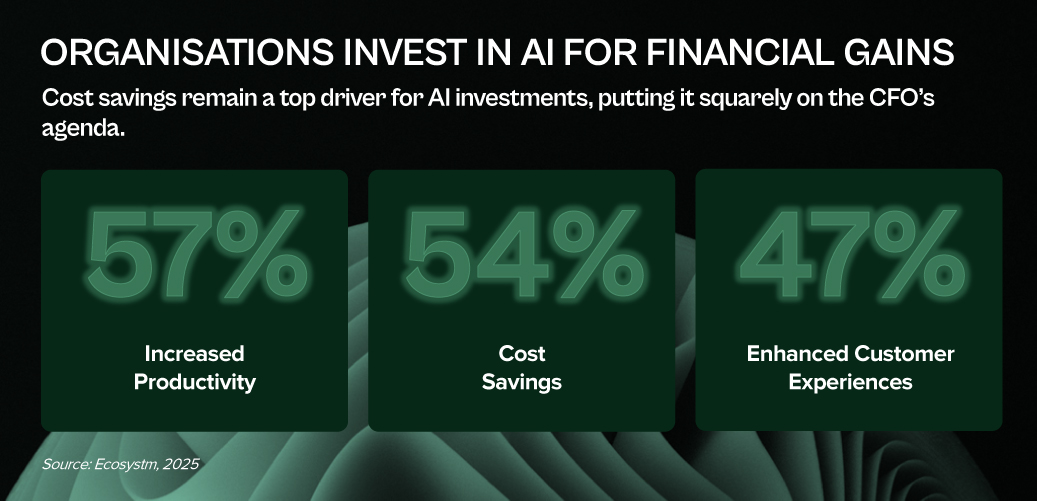
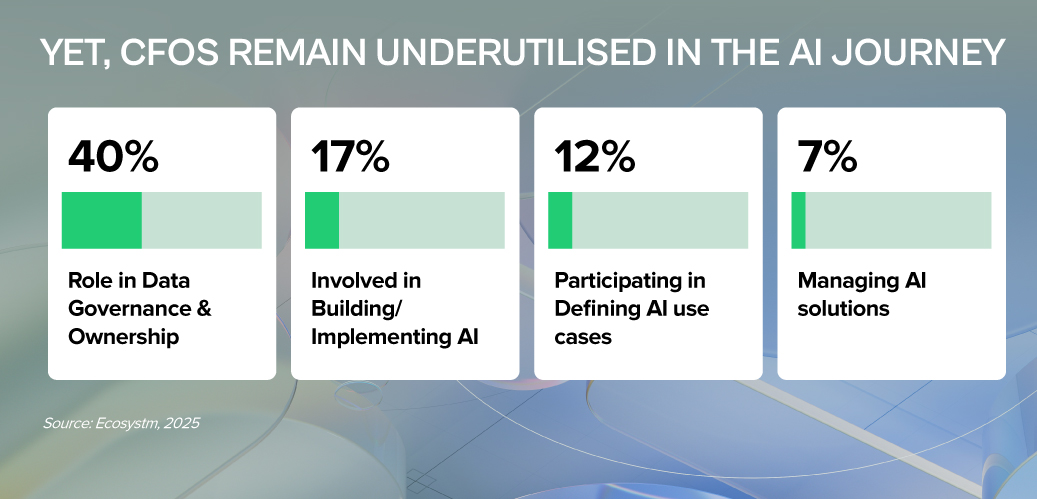
LEAD WITH RIGOUR. SAFEGUARD WITH VIGILANCE. CHAMPION WITH VISION.
That’s the CFO playbook for AI success.
Click here to download “AI Stakeholders: The Finance Perspective” as a PDF.
1. Investor & ROI Gatekeeper: Ensuring AI Delivers Value
CFOs must scrutinise AI investments with the same discipline as any major capital allocation.
- Demand Clear Business Cases. Every AI initiative should articulate the problem solved, expected gains (cost, efficiency, accuracy), and specific KPIs.
- Prioritise Tangible ROI. Focus on AI projects that show measurable impact. Start with high-return, lower-risk use cases before scaling.
- Assess Total Cost of Ownership (TCO). Go beyond upfront costs – factor in integration, maintenance, training, and ongoing AI model management.
Only 37% of Asia Pacific organisations invest in FinOps to cut costs, boost efficiency, and strengthen financial governance over tech spend.
2. Risk & Compliance Steward: Navigating AI’s New Risk Landscape
AI brings significant regulatory, compliance, and reputational risks that CFOs must manage – in partnership with peers across the business.
- Champion Data Quality & Governance. Enforce rigorous data standards and collaborate with IT, risk, and business teams to ensure accuracy, integrity, and compliance across the enterprise.
- Ensure Data Accessibility. Break down silos with CIOs and CDOs and invest in shared infrastructure that AI initiatives depend on – from data lakes to robust APIs.
- Address Bias & Safeguard Privacy. Monitor AI models to detect bias, especially in sensitive processes, while ensuring compliance.
- Protect Security & Prevent Breaches. Strengthen defences around financial and personal data to avoid costly security incidents and regulatory penalties.
3. AI Champion & Business Leader: Driving Adoption in Finance
Beyond gatekeeping, CFOs must actively champion AI to transform finance operations and build future-ready teams.
- Identify High-Impact Use Cases. Work with teams to apply AI where it solves real pain points – from automating accounts payable to improving forecasting and fraud detection.
- Build AI Literacy. Help finance teams see AI as an augmentation tool, not a threat. Invest in upskilling while identifying gaps – from data management to AI model oversight.
- Set AI Governance Frameworks. Define accountability, roles, and control mechanisms to ensure responsible AI use across finance.
- Stay Ahead of the Curve. Monitor emerging tech that can streamline finance and bring in expert partners to fast-track AI adoption and results.
CFOs: From Gatekeepers to Growth Drivers
AI is not just a tech shift – it’s a CFO mandate. To lead, CFOs must embrace three roles: Investor, ensuring every AI bet delivers real ROI; Risk Guardian, protecting data integrity and compliance in a world of new risks; and AI Champion, embedding AI into finance teams to boost speed, accuracy, and insight.
This is how finance moves from record-keeping to value creation. With focused leadership and smart collaboration, CFOs can turn AI from buzzword to business impact.

Retail transformation is a continuous, dynamic journey of reinvention – driven by agility, experimentation, and the need to keep pace with ever-evolving consumer behaviour. It’s not a fixed destination but an ongoing process of innovation.
At its heart, retail transformation is about putting the customer squarely in control. It’s the strategic overhaul that allows retailers to truly understand individual desires, offering hyper-personalised journeys that blur the lines between online browsing and in-store discovery.
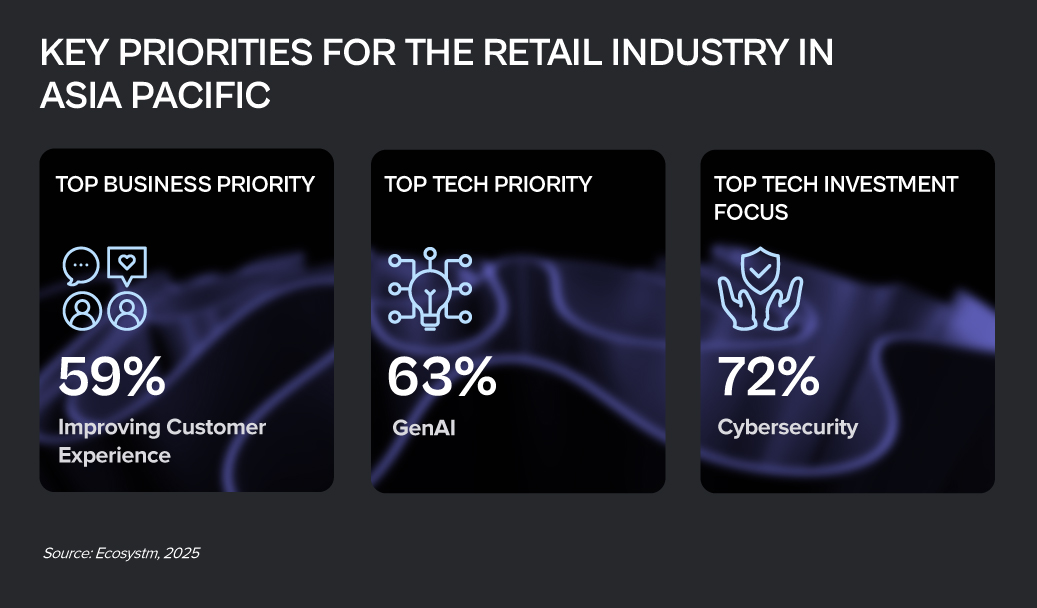
Click here to download “Future Forward: Reimagining Retail” as a PDF.
Enabling Growth with Smarter Sales and Distribution
India’s Tata Consumer Products, aiming to grow their FMCG market share, set out to digitise sales across the vast ‘kirana’-driven retail network.
The company replaced outdated tools with a system that streamlines distributor onboarding, order management, and retail execution – cutting setup times from days to minutes.
A mobile app gives field reps real-time inventory, auto-applied promos, and personalised KPIs, while dashboards give managers live territory insights. Built in seven months, the platform now handles 6M+ transactions monthly, supports 8,000 reps, 12,000 distributors, and 1.6M outlets. Centralised service and rapid feature rollouts keep Tata Consumer fast, responsive, and customer-focused.
Addressing Legacy Limitations
One of New Zealand’s leading grocery retailer, Foodstuffs South Island, faced growing limitations from aging ERP systems and hardware nearing end-of-life.
Instead of reinvesting in outdated tech, FSSI launched Project Petra – a leap to a unified, cloud-based ERP platform.
The shift enabled intelligent replenishment, robotic automation, and a vastly improved user experience. In 18 months, FSSI streamlined roles, rebuilt core apps, and completed a smooth go-live in just three days. The payoff: forecasting and replenishment times cut by up to 50%, faster transactions, seamless price updates, and real-time insights. What began as a tech upgrade became a full transformation – boosting agility, empowering teams, and fuelling future-ready growth.
Streamlining Workflows, Empowering Employees
UCC Group, the Japanese coffee pioneer, is brewing a transformation internally. With 88 locations across 21 countries, UCC faced mounting inefficiencies from outdated legacy systems – slow, complex workflows and clunky portals that frustrated employees and slowed approvals.
UCC replaced their legacy systems with a cloud-first, mobile-first platform.
VPNs were eliminated. Approvals that once took multiple logins now take one tap. A clean, co-designed portal replaced the old interface, putting ease of use first. E-signatures and digitised requests cut paper use by 90% – over 1.5 million forms saved. A new life-event portal launched in just one month, proving speed and simplicity can coexist. Now expanding globally, UCC is unifying ERP, data, and apps into a single, employee-first hub – built for scale, speed, and the future.
Scaling Customer Experience at Speed
Aditya Birla Fashion Retail Limited (ABFRL) faced the challenge of scaling their multi-brand presence without compromising customer experience. As growth surged across stores, online platforms, and marketplaces, their order management system struggled to keep up – putting fulfillment speed, accuracy, and satisfaction at risk.
To solve this, ABFRL implemented a scalable, multi-instance order management solution that streamlined inventory tracking, fulfillment, and refunds.
The result: 99.5% faster inventory sync, zero refund failures, smarter order decisions, and accurate delivery estimates across all channels. This strategic overhaul helped ABFRL maintain service excellence while fuelling sustainable growth – proving that operational agility is key to scaling customer experience at speed.
Solving Reliability & Scalability Challenges
Chicks Lifestyle is a trusted home-grown brand in Hong Kong known for quality innerwear and thermal wear. As they expanded online and geared up for sustainable growth, outdated on-prem systems began to strain under peak-season pressure – causing crashes, long checkout lines, and customer frustration.
To fix this, they migrated their core ERP and POS systems to the cloud in just six weeks with zero data loss.
The result: 99.99% uptime, 30% jump in efficiency, 15% faster checkouts, and 40% lower IT costs. Loyalty data access dropped from minutes to seconds, enabling personalised service at scale. With a stable, scalable tech backbone in place, Chicks Lifestyle is now exploring AI to power their next phase of innovation.

GreenTech is reshaping finance by fusing technology with sustainability. From startups to large financial institutions, there’s a clear push to embed climate intelligence into financial decisions. In 2024, green fintech investments hit USD 2.7B – underscoring strong momentum and growing confidence in tech-led sustainability solutions.
The focus is sharp: drive financial innovation while delivering real environmental impact.
Here’s a look at key Green Finance trends that are reshaping the industry.
Click here to download “The Future of Finance is Digital – and Sustainable” as a PDF.
Catalysing Change: Impact Investing
Impact investing is going mainstream, especially in fast-growing emerging markets.
This shift reflects a growing realisation: private capital is critical to climate action, and tackling climate risks is a financial opportunity, not just an ethical choice.
AVPN (Asian Venture Philanthropy Network) has launched ImpactCollab – a platform linking finance professionals with verified impact organisations, due diligence tools, and monitoring resources. Initially used by private banks in Singapore to bolster philanthropy advisory, it will soon expand into blended finance and impact investing, backed by MAS.
Green bonds are also gaining momentum, driven by investor demand, regulatory tailwinds, and rising climate risk awareness. In Singapore, NUS, UOB, and Northern Trust piloted tokenised green bond reporting to boost transparency. India, meanwhile, opened its sovereign green bonds to foreign investors via the Fully Accessible Route (FAR), unlocking global capital for climate goals.
Empowering Customers with Carbon Insights
Carbon tracking is becoming a staple in digital banking, driven by a growing demand for transparency around environmental impact. Banks are responding by embedding carbon calculators into apps – enabling users to measure emissions, benchmark against national averages, and get actionable tips to reduce their footprint.
In Indonesia, Bank Mandiri has launched an in-app feature that helps customers track their personal carbon emissions, making it easy to understand the environmental impact of daily actions. The Royal Bank of Canada has partnered with a carbon management platform to offer businesses tools to monitor and manage their emissions.
These moves reflect a broader shift: banks are embedding sustainability into everyday financial behaviour and deepening customer engagement through purpose-driven services.

Blockchain-Enabled Carbon Trading
Blockchain is transforming carbon trading by enabling a decentralised, transparent, and secure way to verify and transact carbon credits.
This technology addresses long-standing issues of fraud and inefficiency, offering a more reliable and cost-effective approach to managing credits and meeting climate goals.
Thailand has eased crypto regulations to promote blockchain-based carbon trading, positioning itself as a leader in sustainable tech. Meanwhile, US-based financial services firm Northern Trust has launched a blockchain platform that allows project developers to generate, verify, and trade voluntary carbon credits in near real-time. Together, these moves signal a shift toward mainstream adoption of blockchain in carbon markets.
Addressing the Climate Risk Gap
As climate risks intensify, small and medium enterprises (SMEs) are seeking tools to assess and manage their exposure. Despite being highly vulnerable to climate events, SMEs often lack the resources to navigate complex risk landscapes.
Fintechs are stepping in with climate risk-scoring tools that help SMEs identify vulnerabilities and take proactive steps – such as securing insurance or adapting their strategies.
Marsh has highlighted the need for SME-focused climate assessments in New Zealand, particularly for high-risk sectors. Its Climate Risk Navigator helps businesses build resilience and make informed decisions on insurance and sustainability. In India, insurers like ICICI Lombard are using geospatial tech – GIS, satellite imagery, and AI – to power climate-linked products. For example, its satellite-based insurance for wheat farmers in Punjab enables faster, more accurate yield assessments and claim settlements.
Rise of Climate-Conscious Crypto
Once criticised for high energy use, crypto mining is undergoing a green makeover – fuelled by surplus renewable energy and optimised by AI.
What was seen as wasteful is now being reimagined as a tool for grid stability and sustainable growth.
In Switzerland’s Canton of Bern, Bitcoin mining is being explored as a way to absorb excess power and stabilise the grid. In the UK, mining firms are tapping into unused wind energy during off-peak hours to avoid waste. This shift is reaching emerging markets too – Pakistan is converting surplus electricity into value by launching state-backed Bitcoin mining and AI data centres, turning untapped power into economic opportunity.
Ecosystm Opinion
Becoming truly sustainable presents a unique challenge for financial organisations, as their responsibility extends beyond internal operational efficiencies to actively empowering customers and the wider ecosystem to embrace green practices. This is compounded by a growing reliance on increasingly compute-intensive and energy-inefficient technologies.
The recent and growing emphasis on Green Finance offers a promising outlook, suggesting a positive shift in the industry’s trajectory towards a more sustainable future.

Advanced technology and the growing interconnectedness of devices are no longer futuristic concepts in health and life sciences – they’re driving a powerful transformation. Technology, combined with societal demands, is reshaping drug discovery, clinical trials, patient care, and even our understanding of the human body.
The potential to create more efficient, personalised, and effective healthcare solutions has never been greater.
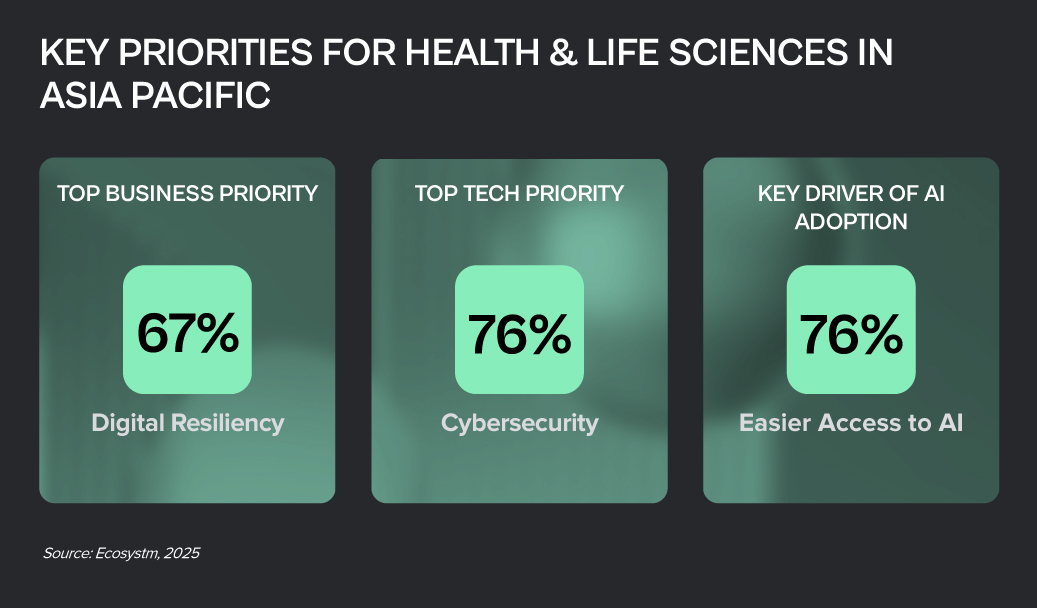
Click here to download “Future Forward: Reimagining Health & Life Sciences” as a PDF.
Modernising HR for Enhanced Efficiency & Employee Experience
The National Healthcare Group (NHG), a leading public healthcare provider in Singapore, recognised the need to modernise their HR system to better support 20,000+ healthcare professionals and improve patient services.
The iConnect@NHG initiative was launched to centralise HR functions, providing mobile access and self-service capabilities, and streamlining workflows across NHG’s integrated network of hospitals, polyclinics, and specialty centres.
The solution streamlined HR processes, giving employees easy access to essential data, career tools, and claims. The cloud-based platform improved data accuracy, reduced admin work, and integrated analytics for better decision-making and engagement. With 95% adoption, productivity and job satisfaction surged, enabling staff to focus on care delivery.
Automating Workflows for Better Patient Outcomes
Gold Coast Health handles a high volume of patient interactions across a wide range of medical services. The challenge was to streamline operations and reduce administrative burdens to improve patient care.
The solution involved automating the patient intake process by replacing paper forms with electronic versions, freeing up significant staff time.
A new clinical imaging solution also automates the uploading of wound images and descriptions into patient records, further saving time. Additionally, Gold Coast Health implemented a Discharge to Reassess system to automate follow-ups for long-term outpatient care. They are also exploring AI to simplify tasks and improve access to information, allowing clinical teams to focus more on patient care.
Streamlining Operations, Improving Care
IHH Healthcare, a global provider with over 80 hospitals across 10 countries, faced a fragmented IT landscape that hindered data management and patient care.
To resolve this, IHH migrated their core application workloads, including EMRs, to a next-gen cloud platform, unifying data across their network and enhancing analytics.
Additionally, they adopted an on-prem cloud solution to comply with local data residency requirements. This transformation reduced report generation time from days to hours, boosting operational efficiency and improving patient and clinician experiences. By leveraging advanced cloud technologies, IHH is strengthening their commitment to delivering world-class healthcare.
Creating Seamless & Compassionate Patient Journeys
The Narayana Health group in India is committed to providing accessible, high-quality care. However, they faced challenges with fragmented patient data, which hindered personalised care and efficient interactions.
To address this, Narayana Health centralised patient data, providing agents with a 360-degree view to offer more informed and compassionate service.
By automating tasks like call routing and form-filling, the organisation reduced average handling times and increased appointment conversions. Additionally, automated communication tools delivered timely, sensitive updates, strengthening patient relationships. The initiative has improved operational efficiency and deepened the organisation’s patient-centric focus.
Reimagining Location Services for Digital Healthcare
Halodoc, a leading digital health platform in Indonesia, connects millions of users with healthcare professionals and pharmacies.
To improve key services like home lab appointments and medicine delivery, Halodoc sought a more cost-effective and secure location service.
The transition resulted in an 88% reduction in costs for geocoding and places functionalities while enhancing data security. With better performance monitoring, Halodoc processed millions of geocoding and place requests with no major issues. This migration not only optimised costs but also resolved long-standing technical challenges, positioning Halodoc for future innovation, including machine learning and AI. The move strengthened their data security and provided a solid foundation for continued growth and high-quality healthcare delivery across Indonesia.
Driving Efficiency & Accessibility through Integrated Systems
Lupin, a global pharma leader, aimed to boost patient care, streamline operations, and enhance accessibility. By integrating systems and centralising data, Lupin wanted seamless interactions between patients, doctors, and the salesforce.
The company implemented a scalable infrastructure optimised for critical business applications, backed by high-performance server and storage technologies.
This integration improved data-driven decision-making, leading to optimised operations, reduced costs, and improved medicine quality and affordability. The robust infrastructure also ensured near-zero downtime, enhancing reliability and efficiency. Through this transformation, Lupin reinforced its commitment to providing patient-centred, affordable healthcare with faster, more efficient outcomes.
Leveraging AI for Cloud Security
Mitsubishi Tanabe Pharma’s “VISION 30” seeks to deliver personalised healthcare by 2030, focusing on precision medicine and digital solutions. The company is investing in advanced digital technologies and secure data infrastructure to achieve these goals.
To secure their expanding cloud platform, the company adopted a zero-trust model and enhanced identity management.
A security assessment identified gaps in cloud configuration, prompting tailored security improvements. GenAI was introduced to translate and summarise security alerts, reducing processing time from 10 minutes to just one minute, improving efficiency and security awareness across the team. The company is actively exploring further AI-driven solutions to strengthen security and drive their digital transformation, advancing the vision for personalised healthcare.

The Manufacturing sector, traditionally defined by stable processes and infrastructure, is now facing a pivotal shift. Rapid technological advancements and shifting global market dynamics have rendered incremental improvements inadequate for long-term competitiveness and growth. To thrive, manufacturers must fundamentally reimagine their entire value chain.
By embracing intelligent systems, enhancing agility, and proactively shaping future-ready operations, organisations can navigate today’s industrial complexities and position themselves for sustained success.
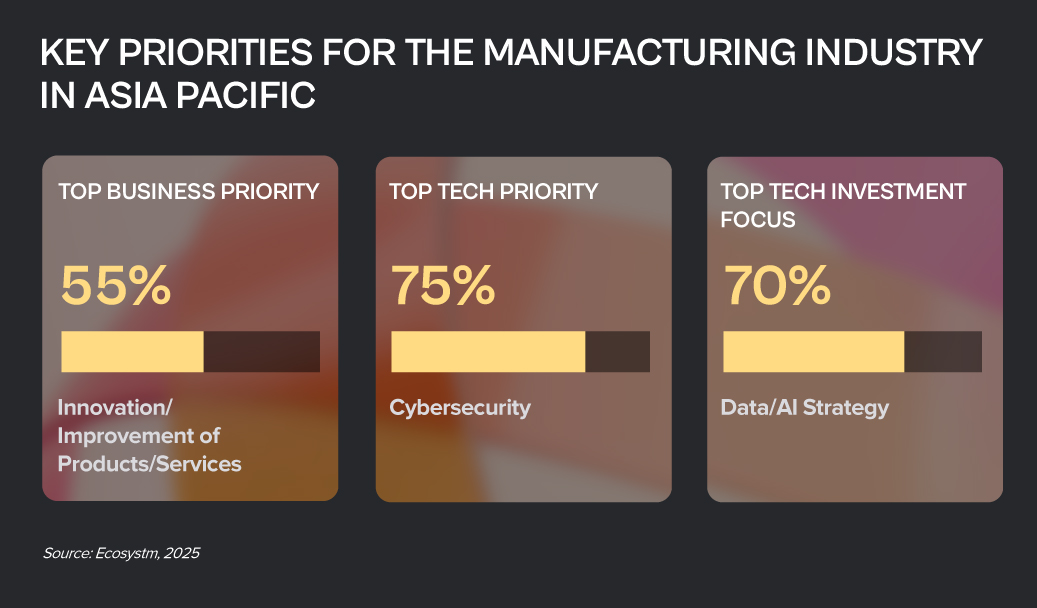
Here are recent examples of Manufacturing transformation in the Asia Pacific.
Click here to download “Future Forward: Reimagining Manufacturing” as a PDF.
Intelligent Automation & Efficiency
Komatsu Australia, a global industrial equipment manufacturer, tackled growing inefficiencies in its small parts department, where teams manually processed hundreds of PDF invoices daily from more than 250 suppliers.
To streamline this, the company deployed intelligent automation – AI now extracts and validates data from invoices against purchase orders and inputs it directly into the legacy mainframe.
The impact has been sharp: over 300 hours saved annually for one supplier, 1,100 invoices processed in three weeks, and a dramatic drop in manual errors. Employees have shifted to higher-value tasks, and a citizen developer program is enabling staff to build custom automation tools. With a scalable framework in place, Komatsu has not only transformed invoice processing but also set the stage for broader automation across the enterprise.
Data-Driven Insights & Agility
Berger Paints India Ltd., a leader in paints and coatings, needed to scale fast amid rising database loads and complex on-prem systems.
In response, Berger Paints migrated its mission-critical databases and core business applications – covering finance, manufacturing, sales, and asset management – to a high-performance cloud platform.
This shift boosted operational efficiency by 25%, doubled reporting and system response times, and enhanced scalability and disaster recovery with geographically distributed cloud regions. The move simplified access to data, driving faster, insight-driven decision-making. With streamlined infrastructure management and optimised costs, Berger Paints is now poised to leverage advanced technologies like AI/ML, setting the stage for continued innovation and growth.
Connected Operations & Customer Centricity
JSW Steel, one of India’s leading steel producers, set out to shift from a plant-centric model to a customer-first approach. The challenge: integrating complex systems like ERP, CRM, and manufacturing to streamline operations and improve order fulfillment.
With a robust integration platform, JSW Steel connected over 32 systems using 120+ APIs – automating processes and enabling real-time data flow across orders, inventory, pricing, and production.
The results speak for themselves: faster order fulfillment, reduced cost-to-serve, and real-time visibility that optimises scheduling. Scalable, composable APIs now support growth, while a 99.7% success rate across 7.2 million API calls ensures reliability. JSW Steel has transformed how it operates – running faster, serving smarter, and delivering better customer experiences across the entire order-to-cash journey.
Modernising Core Systems & Foundational Transformation
Fujitsu General, a global leader in air conditioning systems, was constrained by a 30-year-old COBOL-based mainframe and fragmented processes. The legacy system posed a Y2K-like risk and limited operational agility.
The company implemented a modern, unified ERP platform to eliminate risk, streamline operations, and boost agility.
By integrating functions across sales, production, procurement, accounting, and HR and addressing unique business needs with low-code development, the company created a clean, adaptable core system. Robust integration connected disparate data sources, while a central repository eliminated silos. The transformation delivered seamless end-to-end operations, standardised workflows, improved agility, and real-time insights – setting Fujitsu General up for continued innovation and long-term resilience.
Powering Growth with a Modern Network
As a critical supplier to India’s infrastructure boom, Hindalco needed to modernise its network across 55 sites – improving app performance, enabling real-time insights, and building a future-ready, sustainable foundation.
Hindalco replaced its ageing hub-and-spoke model with a modern mesh architecture using SD-WAN.
The new architecture prioritised key app traffic, simplified cloud access, and enabled segmentation. Centralised orchestration and SSE integration brought automation and robust security. The impact: 30% lower costs, 50% faster apps, real-time visibility, rapid deployment, and smarter bandwidth. Hindalco now runs on a lean, secure digital backbone – built for agility, performance, and scale.

Home to over 60% of the global population, the Asia Pacific region is at the forefront of digital transformation – and at a turning point. The Asian Development Bank forecasts a USD 1.7T GDP boost by 2030, but only if regulation keeps pace with innovation. In 2025, that alignment is taking shape: regulators across the region are actively crafting policies and platforms to scale innovation safely and steer it toward public good. Their focus spans global AI rules, oversight of critical tech in BFSI, sustainable finance, green fintech, and frameworks for digital assets.
Here’s a look at some of the regulatory influences on the region’s BFSI organisations.
Click here to download “Greener, Smarter, Safer: BFSI’s Regulatory Agenda” as a PDF.
The Ripple Effect of Global AI Regulation on APAC Finance
The EU’s AI Act – alongside efforts by other countries such as Brazil and the UK – signals a global shift toward responsible AI. With mandates for transparency, accountability, and human oversight, the Act sets a new bar that resonates across APAC, especially in high-stakes areas like credit scoring and fraud detection.
For financial institutions in the region, ensuring auditable AI systems and maintaining high data quality will be key to compliance. But the burden of strict rules, heavy fines, and complex risk assessments may slow innovation – particularly for smaller fintechs. Global firms with a footprint in the EU also face the challenge of navigating divergent regulatory regimes, adding complexity and cost.
APAC financial institutions must strike a careful balance: safeguarding consumers while keeping innovation alive within a tightening regulatory landscape.
Stepping Up Oversight: Regulating Tech’s Role
Effective January 1, 2025, the UK has granted the Financial Conduct Authority (FCA) and Bank of England oversight of critical tech firms serving the banking sector. This underscores growing global recognition of the systemic importance of these providers.
This regulatory expansion has likely implications for major players such as AWS, Google, and Microsoft. The goal: strengthen financial stability by mitigating cyber risks and service disruptions.
As APAC regulators watch closely, a key question emerges: will similar oversight frameworks be introduced to protect the region’s increasingly interconnected financial ecosystem?
With heavy reliance on a few core tech providers, APAC must carefully assess systemic risks and the need for regulatory safeguards in shaping its digital finance future.
Catalysing Sustainable Finance Through Regional Collaboration
APAC policymakers are translating climate ambitions into tangible action, exemplified by the collaborative FAST-P initiative between Australia and Singapore, spearheaded by the Monetary Authority of Singapore (MAS).
Australia’s USD 50 million commitment to fintech-enabled clean energy and infrastructure projects across Southeast Asia demonstrates a powerful public-private partnership driving decarbonisation through blended finance models.
This regional collaboration highlights a proactive approach to leveraging financial innovation for sustainability, setting a potential benchmark for other APAC nations.
Fostering Green Fintech Innovation Across APAC Markets
The proactive stance on sustainable finance extends to initiatives promoting green fintech startups.
Hong Kong’s upcoming Green Fintech Map and Thailand’s expanded ESG Product Platform are prime examples. By spotlighting sustainability-focused digital tools and enhancing data infrastructure and disclosure standards, these regulators aim to build investor confidence in ESG-driven fintech offerings.
This trend underscores a clear regional strategy: APAC regulators are not merely encouraging green innovation but actively cultivating ecosystems that facilitate its growth and scalability across diverse markets.
Charting the Regulatory Course for Digital Asset Growth in APAC
APAC regulators are gaining momentum in building forward-looking frameworks for the digital asset landscape. Japan’s proposal to classify crypto assets as financial products, Hong Kong’s expanded permissions for virtual asset activities, and South Korea’s gradual reintroduction of corporate crypto trading all point to a proactive regulatory shift.
Australia’s new crypto rules, including measures against debanking, and India’s clarified registration requirements for key players further reflect a region moving from cautious observation to decisive action.
Regulators are actively shaping a secure, scalable digital asset ecosystem – striking a balance between innovation, strong compliance, and consumer protection.
Ecosystm Opinion
APAC regulators are sending a clear message: innovation and oversight go hand in hand. As the region embraces a digital-first future, governments are moving beyond rule-setting to design frameworks that actively shape the balance between innovation, markets, institutions, and society.
This isn’t just about following global norms; it’s a bold step toward defining new standards that reflect APAC’s unique ambitions and the realities of digital finance.

The education sector is evolving rapidly, driven by technological innovation and shifting societal needs. This transformation extends beyond digitisation, requiring a fundamental rethink of how students and employees engage. AI-driven personalisation, immersive virtual environments, and data analytics are reshaping curricula, teaching strategies, and operational efficiency.

Here are recent examples of transformation across the Asia Pacific.
Click here to download “Future Forward: Reimagining Education” as a PDF.
Streamlining Service Delivery
Griffith University struggled with fragmented systems and siloed information, leading to inconsistent service and inefficiencies. Managing support for over 45,000 students became unsustainable, demanding a streamlined solution.
By adopting an enterprise service management platform, Griffith consolidated multiple portals into a single system, automating ticketing, request management, and AI-driven self-service.
Starting with library services, the transformation expanded across IT, HR, legal, and other functions, improving accessibility and collaboration. The impact was immediate: self-service surged by 87%, first-contact resolution jumped by 43%, and incident resolution time dropped by 25%. Call volume fell 31% and email inquiries 46%. Now scaling the platform university-wide, Griffith is streamlining service for students and staff.
AI for Recruitment & Content
The Indian Institute of Hotel Management (IIHM) sought to improve recruitment efficiency and enhance educational content creation. Manual hiring processes were slow and inconsistent, while developing high-quality learning materials was resource-intensive.
IIHM implemented an AI-driven platform to automate candidate assessments and generate accurate, engaging educational content.
This transformation cut interview times by half, improved hiring precision to 90%, and boosted student job placements by up to 30%. AI-generated materials reached 95% accuracy, creating a more effective learning experience. With stronger recruitment and enriched education, IIHM continues to reinforce its leadership in hospitality training.
AI-Accelerated Research
La Trobe University sought to harness GenAI to streamline research operations and accelerate market entry. Researchers faced challenges in accessing university-approved knowledge efficiently, while limited development capabilities slowed the commercialisation of research findings.
By implementing a retrieval-augmented generation (RAG) system, La Trobe enabled rapid, AI-powered access to research data, initially tested on autism studies.
Simultaneously, the university co-developed an AI-driven application to transform research into market-ready solutions faster. AI-driven development reduced time from months to weeks, with core components built in under a week. By leveraging in-house AI tools, La Trobe achieved an 8.7x cost reduction compared to outsourcing. This initiative positioned the university as a leader in AI-driven innovation, bridging the gap between academia and industry.
AI-Driven Personalisation
BINUS University aimed to future-proof its operations and student learning experiences. With GenAI reshaping education, the university sought to integrate AI into administration and teaching to boost efficiency and deliver adaptive, personalised learning.
BINUS has integrated AI across key areas, driving efficiency and personalisation.
AI-powered student intake predictions have reached 90% accuracy, optimising resource allocation across 14 campuses. GenAI automates Diploma Supplement Document (DPI) creation, reducing manual effort and improving accuracy. AI enhances the library system with personalised book recommendations and powers the AI Tutor for faster, tailored academic feedback. AI-driven language learning platforms further boost student engagement.
Unified Digital Workflows
Western Sydney University (WSU) faced inefficiencies from over 32 shared email addresses and paper-based forms, causing delays, poor inquiry tracking, and complicated administration – hindering timely, effective support.
WSU launched WesternNow to replace outdated systems with a unified digital platform, streamlining service requests, enhancing case tracking, cutting manual processes, and improving the user experience for students and staff.
This made WSU’s service delivery more responsive and efficient. The platform drastically improved efficiency, cutting request logging time from over 4 minutes to seconds. Staff tracked and resolved cases seamlessly without sifting through emails. Workflow digitisation eliminated most paper forms, saving time and resources, while consolidating forms into services reduced their number by 40%.



